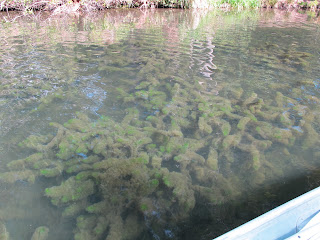 |
| Yellow flag iris has made this drainage ditch unusable. |
Our draft environmental study reviews eight new chemicals, five alternatives for management, and updates information on other chemicals currently covered under the permits. We're seeking your feedback now through June 6.
Environmental management:
the balancing act
Sometimes, protecting the environment requires us to choose between two imperfect options. Just as you might turn to cold medicine to treat your body when you’re sick, we permit the use of some chemicals to help maintain the health of our waterways.Noxious weeds are non-native plants that are highly destructive, competitive, or difficult to control. Nuisance plants are native, but they are growing in an area – or density – that causes damage the surrounding environment. These plants choke irrigation ditches, cover our lakes in green slime, and can be a risk to public health. While we work hard to keep chemicals out of Washington waters, we allow them under very specific circumstances to help manage these plants and algae.
Caring for the environment is a delicate balancing act. Our permits require people to use management solutions that have the least environmental impact among reasonably available options. Over the years, we’ve found chemicals sometimes can be the least invasive solution to control the plants and algae that throw off our natural balance.
Evaluating the chemicals covered by our water quality permits
We issue permits that allow the use of chemicals to conditionally treat noxious weeds, native nuisance plants, and algae in and around water. Two of these permits cover the use of chemicals in Washington waters. These are the Aquatic Plant and Algae Management and Aquatic Noxious Weed Control general permits. Our scientific review allows us to determine if we should – or should not – allow specific chemicals under our permits.For these permits, we’ve evaluated:
 |
| Algae under a microscope. |
- Algaecides - A chemical compound that kills or reduces the growth of algae or cyanobacteria (known as toxic algae or blue-green algae).
- Herbicides - A chemical compound that kills or inhibits the growth of plants.
- Phosphorus inactivation products - Products used to bind phosphorus in the water column and sediments making it unavailable to aquatic life. Phosphorus is a key ingredient in algae blooms.
Learn more about invasive plants and the risks they cause to our way of life from the Washington Noxious Weed Control Board.
Why not just remove them by hand?
Non-chemical options are not always the best solution with the least environmental impact. Physical and mechanical methods of removing these plants can be damaging to aquatic habitats. These non-chemical options can have negative effects on water quality, disrupt sediment, and can kill the insects, snails, and fish trapped in the plants. These methods may be so expensive that they’re not really attainable to water managers. In addition, they can lead to a new infestation of noxious weeds by leaving behind plant fragments that then take root in the sediment.
Allowing pesticides to manage Washington waters
The federal Clean Water Act gives Ecology the responsibility to protect state waters. Chemicals used to manage Washington waters must be approved for use by the U.S. Environmental Protection Agency and Washington State Department of Agriculture. As a third layer of protection, we require anyone wanting to use one of these chemicals to get a water quality permit from us.Water quality permits are a legal tool to allow – and limit – a discharge of pollution into the water. Each permit is different and sets specific methods for release, monitoring, and mitigating any potential environmental damage.
 |
| When used carefully under a water quality permit, chemicals can help maintain the waters we love. Photo credit: Tristan Hervouet via freeimages |
For example, water management protects:
- Community use
- Aquatic habitat
- Human and pet health
- Agricultural purposes
- Livestock
- Commerce and navigation
- Boating
- Recreational and commercial fishing
- And much more
Our current environmental review
We recently completed our draft of a new environmental review for our general permits for managing Washington waters. This review, called a Supplemental Environmental Impact Statement (EIS), helps us determine the potential environmental impact of certain chemicals used to treat unwanted plants and algae. Now, we want your feedback on our draft before we finalize the report. |
| Variable-leaf milfoil in Blue Lake. |
Protecting the health of the native ecosystem is our top priority. New information is learned all the time, so it’s important to continually review what we permit with the best science and technology available.
This environmental review is neither a permit nor a decision, but it will inform decisions we make around aquatic plant management in the future.
Send us your comments
We are now accepting comments on our environmental review of the chemicals used in these two permits. We will take input on the Draft SEIS for Aquatic Plant Management until 5 p.m. on June 6, 2017.
We will also accept comments by mail:
We will also accept comments by mail:
Nathan Lubliner
Washington State Department of Ecology
PO Box 47696
Olympia, WA 98504-7696
Washington State Department of Ecology
PO Box 47696
Olympia, WA 98504-7696



No comments:
Post a Comment